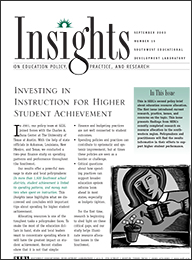States and districts can develop a more systematic approach
Most people would agree (at least in theory) with the idea that local decisions about spending could be enhanced by better data collection, analysis, and reporting strategies. In the spirit of finding common ground, we encourage state leaders to think carefully about the school district procedures we recommend and to consider whether statewide changes might be needed. And in turn, we urge district leaders to consider the potential benefits if the state procedures we suggest are carried out.
State level
While our study focused on school districts, some crucial suggestions for state-level policymakers emerged. These ideas reflect a need for new systemwide tools and greater concern about how to help local leaders with implementation issues.
- Work with local policymakers to determine how to increase spending in priority areas and whether reallocation of existing resources is a viable option.
- Tie data on resources directly to specific educational programs, staffing configurations, and other improvement strategies so that cost-benefit and other analyses can be conducted.
- Ensure that districts have the data they need before the school year begins so that staff can use summer months to plan activities and budgets for the coming year.
- Give guidance to districts about prioritizing resources toward providing professional development, realigning staffing structures to accommodate the strengths and weaknesses of existing staff, and finding ways to recruit and retain quality staff.
- Pay special attention to the staff and system capacity needs in low-performing districts to ensure that a critical mass of educators, leaders, and community members gain the skills needed to succeed in using a more systematic approach.
School district level
What is “needs-based budgeting”?
Needs-based budgeting is a strategy for resource allocation in which school faculty, staff, and community members identify their highest priorities and have opportunities to make a case for reallocating resources in support of those priorities.Although the improvement districts did not bring in more money over time than their comparison districts, they did tend toward an approach that we term “needs-based budgeting.” Needs-based budgeting focuses on school faculty, staff, and community identifying their highest priorities and making a case for resource allocation. Several examples from our interviews illustrate this strategy.
In one district, each school was asked to submit a budget to the district detailing the resources needed to carry out an improvement plan. If an important instructional expense could not be paid by categorical funds or outside grants, then district operating funds were used, but only if the expense could be justified as critical to the school’s improvement plan. In another site, district and campus leaders drew from a mix of available fund sources to support the goals that emerged from a needs assessment. In a small district, teachers and principals reported they were encouraged individually to submit requests for resources to the district, with the message that if the need could be justified, the money would be found to fund them.
Our study underscores the fact that aligning resources to improvement goals is a way of doing business and not simply a reflection of expenditure line items or intentions stated in an improvement plan. At the district level, several processes emerged as guides to local decision making:
- Recognize that one size does not fit all. In planning an approach to allocating resources, weigh heavily the specific circumstances of students and of each school in addition to the district as a whole.
- Seek and use input from parents, teachers, and administrators who have examined and discussed achievement data.
- Support school-level efforts to build parent and community support and develop districtwide programs that encourage the participation of these outside resources.
- Never cease communicating about the importance of allocating or reallocating resources from across the district in support of the goals.
- Spell out the district’s accomplishments and strategies for meeting goals, establishing strong ties to the local business community, and partnering with local initiatives and agencies that serve the needs of children and families.
- Become familiar with state and federal funding regulations and make sure financial managers are skilled in their trade and have a deep understanding of district improvement goals and strategies so that they can give educators the greatest financial flexibility in meeting priorities.
- Develop the grant-writing skills of staff and critically assess the potential distraction and time cost of seeking grants before applying.

Next Page: Next Steps

